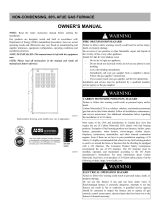
4
WARNING:
It is imperative to maintain proper operation of the
venting system, including the masonry chimney (if
applicable). Insufficient venting could create the
production of excessive amounts of Carbon Monoxide
(CO) - a colorless, odorless gas that is produced during
incomplete combustion of any fuel. It can cause death
without warning. Carbon monoxide poisoning can
cause flu- like symptoms and also dizziness, fatigue,
headaches, nausea, and irregular breathing.
If you suspect that you are experiencing CO poisoning,
get fresh air immediately. Leave the home and call
for assistance from a neighbor’s home.
CAUTION:
This furnace requires unrestricted airflow for
combustion and ventilation. For proper and safe
operation, it is extremely important that the furnace
receives an unobstructed flow of clean, fresh air to
properly burn the fuel gas. If this flow of air is restricted,
the partially burned combustion gases may create
dangerous amounts of carbon monoxide that can
cause personal injury or death.
• Do not block or obstruct air openings on the furnace, air
openings or spacings around the furnace area or the room
or closet the furnace is in. Furniture and drapery should be
arranged so that the supply air registers and return grilles are
not obstructed.
• The U.S. Consumer Product Safety Commission (CPSC)
recommends every home have a Carbon Monoxide detector
in hallways near the bedrooms in each sleeping area. CO
detectors should be certified to the most recent requirements
of the UL, IAS OR CSA Standard and should be installed,
operated, and maintained in accordance with the detector
manufacturers instructions.
• If your furnace obtains its air through a pipe to the outdoors,
do not allow the inlet of the pipe to become blocked. If the
furnace is operated without adequate air for combustion, the
flame roll-out switch will open, turning off the gas supply to
the burners. This indicates that a serious problem with the
burners has occurred and must be corrected immediately.
Only a licensed HVAC technician can reset this switch.
• Before remodeling near the furnace, consult with a local code
official or the National Fuel Gas Code to make sure you will be
in compliance with supplying adequate air for combustion. By
erecting new walls, it is sometimes possible to inadvertently
restrict the furnace’s air supply. You can find more information
about supplying combustion air in the NFGC, which is available
at many libraries.
FILTER
WARNING:
Never operate the furnace without a filter in place.
Accumulating dust in the return air can build up on
internal components, resulting in loss of efficiency,
equipment damage, and possible fire.
Keep air filters cleaned. Clean or replace filter to maintain proper
airflow and achieve maximum efficiency. Refer to page 7 for
Maintenance & Inspection information.
CLEARANCES TO COMBUSTIBLES
WARNING:
Do not place combustible materials on or against
the furnace cabinet or within 6 inches of the vent
pipe. Furnace area must be kept clear and free of
combustible materials, gasoline and other flammable
vapors and liquids. A fire or explosion may result
causing property damage, personal injury or loss of
life. Failure to follow the safety warnings exactly could
result in serious injury, death or property damage.
The furnace is designed to have certain clearances to combustible
items such as wood, paper, etc. Some types of insulation are
combustible. If your furnace is installed in an attic, near unfinished
walls, or in other insulated space, keep area surrounding the
furnace free of insulating material.
SOURCES OF COROSION
It is known that certain common household chemicals can
cause heat exchanger corrosion if the vapors are pulled into
the furnace’s burners The following is a list of chemicals that
should not be used or stored near the furnace.
Do not store these chemicals near the furnace:
• Permanent wave solutions
• Chlorinated waxes and cleaners
• Chlorine based swimming pool chemicals
• Water softening chemicals
• De-icing salts or chemicals
• Carbon tetrachloride
• Halogen type refrigerants
• Cleaning solvents (perchloroethylene)
• Printing inks, paint removers, varnishes, etc.
• Hydrochloric acid
• Cements and glues
• Antistatic fabric softeners
• Masonry acid washing materials
FLOOD DAMAGE
WARNING:
Do not use this furnace if any part has been under
water. A flood damaged furnace is extremely
dangerous. Attempts to use the furnace can result in
fire or explosion. A qualified service agency should
be contacted to inspect the furnace and to replace all
gas controls, control system parts, electrical parts that
have been wet or the furnace if deemed necessary.
AVERTISSEMENT:
Ne pas installer ce générateur d’air chaud si l’une de ses pièces a
été immergée dans de l’eau. Un générateur d’air chaud endommagé
par une inondation est extrêmement dangereux. Toute tentative
d’utiliser le générateur d’air chaud peut entraîner un incendie
ou une explosion. Il faut communiquer avec un organisme de
service qualifié pour l’inspection du générateur d’air chaud et le
remplacement de toutes pièces électriques ou parties du système
de commande qui ont été mouillées ou immergées.








